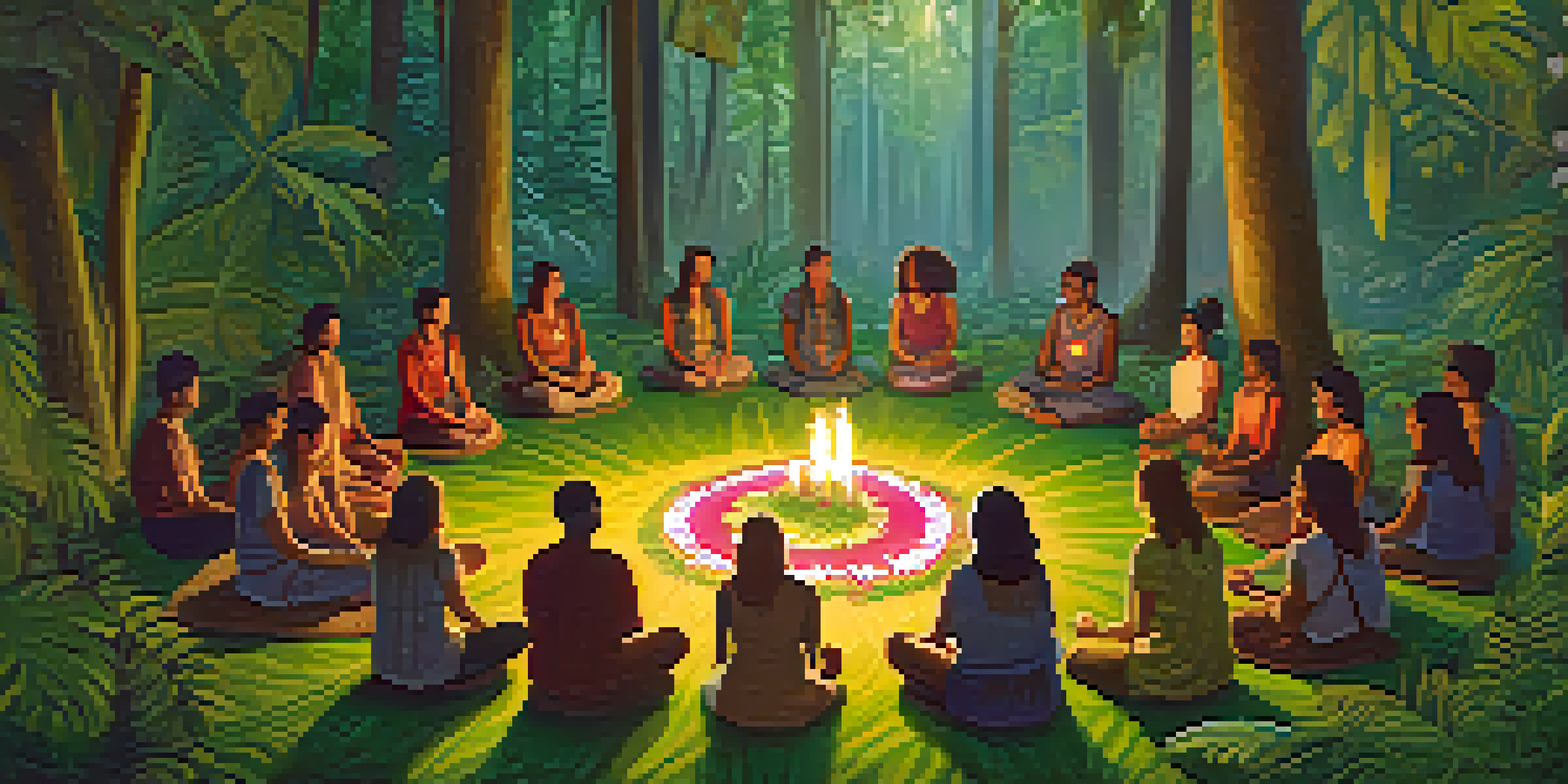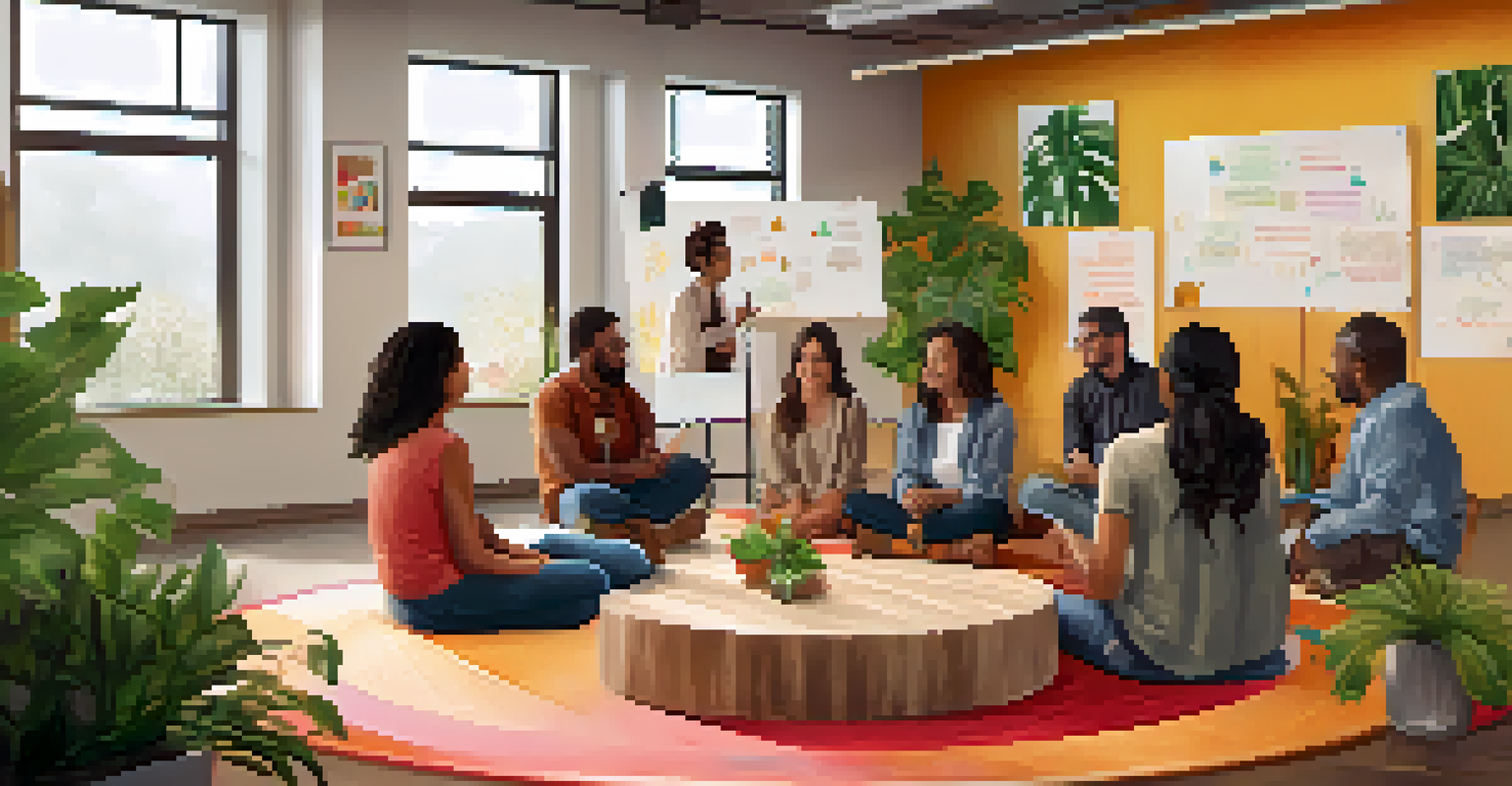Exploring the Social Dynamics of Ayahuasca Ceremony Groups

The Essence of Ayahuasca Ceremonies and Their Setting
Ayahuasca ceremonies are deeply rooted in indigenous traditions, often held in serene environments that foster introspection and healing. Participants gather in circles, creating a sense of community and shared purpose, which enhances the overall experience. The ceremonial setting, usually adorned with natural elements, encourages a connection not just with the plant medicine but also with fellow participants. This unique ambiance sets the stage for profound social interactions and emotional exchanges.
We are all connected; to each other, to the Earth, to the universe.
As individuals come together, they bring their unique life stories, struggles, and aspirations, which can lead to a rich tapestry of shared experiences. The ceremony acts as a catalyst for bonding, where vulnerability is welcomed and often celebrated. This communal aspect helps participants feel less isolated in their journeys, promoting a sense of belonging that is crucial for emotional healing. Through this collective experience, profound connections can be formed that may last well beyond the ceremony itself.
Moreover, the guidance of a knowledgeable facilitator or shaman plays a pivotal role in shaping the social dynamics within the group. Their presence helps establish trust and safety, allowing participants to open up and share their experiences more freely. This guidance not only helps navigate the emotional landscapes that arise during the ceremony but also strengthens the bonds among participants, fostering a supportive environment for growth and healing.
The Role of Trust and Vulnerability in Group Dynamics
Trust is a cornerstone of any successful ayahuasca ceremony, influencing how participants interact with one another. When individuals feel safe to express their innermost thoughts and emotions, it cultivates an atmosphere of vulnerability. This openness often leads to deeper conversations and connections, allowing participants to empathize with each other’s journeys. As stories unfold, the group collectively navigates the complex terrain of healing, reinforcing the bond among members.

Vulnerability in these settings can be both challenging and liberating. Many participants may arrive with apprehensions about sharing their personal experiences, yet the shared journey often encourages a release of those fears. This cycle of sharing and support creates a powerful dynamic, where individuals feel uplifted and understood. It’s this very exchange that can transform a group of strangers into a tight-knit community, united in their pursuit of healing and self-discovery.
Community Enhances Healing Journeys
The communal aspect of ayahuasca ceremonies fosters a sense of belonging and support, which is crucial for emotional healing.
As participants bear their souls, they often find that their struggles resonate with others, creating a sense of collective catharsis. This shared vulnerability not only enhances individual healing but also strengthens the overall group dynamic. The emotional support can be transformative, as participants realize they are not alone in their experiences. This realization fosters a sense of solidarity and encourages ongoing connections beyond the ceremony.
Cultural Influences on Group Interaction and Behavior
The cultural backgrounds of participants can significantly impact social dynamics within ayahuasca ceremonies. Different cultures have varying norms regarding emotional expression, communication styles, and approaches to healing. These cultural influences can create a rich diversity in perspectives, which may enhance group discussions and broaden understanding. However, they can also lead to misunderstandings, requiring sensitivity and awareness among participants.
The greatest healing therapy is friendship and love.
For instance, individuals from cultures that prioritize communal living may find it easier to share and connect compared to those from more individualistic societies. This difference can manifest in how people express gratitude, engage with the group, or process their experiences. Facilitators often play a crucial role in bridging these cultural divides, helping to create an inclusive environment where everyone feels respected and valued. Their awareness of cultural nuances helps foster an atmosphere of acceptance and understanding.
As participants navigate these cultural dynamics, they may find themselves challenged to step outside their comfort zones. Engaging with differing perspectives can lead to personal growth and a broader worldview. By embracing this diversity, participants enrich their own experiences while also contributing to the collective wisdom of the group. Ultimately, the interplay of cultural influences can deepen the overall impact of the ceremony, highlighting the interconnectedness of human experiences.
The Impact of Shared Experiences on Group Cohesion
Shared experiences during ayahuasca ceremonies can profoundly impact group cohesion. As participants undergo intense emotional and spiritual journeys together, these moments create lasting memories that bind them. The act of facing fears, healing traumas, and achieving insights in unison fosters a sense of camaraderie that is difficult to replicate in other contexts. This shared journey often leads to a deep sense of loyalty and connection among participants.
The emotional intensity of the experience can act as a powerful glue, strengthening relationships through mutual support. Participants often find themselves cheering each other on, celebrating breakthroughs, and providing comfort during challenging moments. These interactions not only enhance individual healing but also cultivate a nurturing environment where everyone feels empowered to grow. This sense of belonging can be transformative, as participants realize they have a supportive network to lean on.
Trust and Vulnerability Build Bonds
Establishing trust and embracing vulnerability among participants cultivates deeper connections and empathy during the ceremony.
Furthermore, the bonds formed during these ceremonies can have lasting effects on participants' lives outside the group. Many individuals maintain contact with fellow participants, continuing to support each other in their healing journeys. This ongoing connection illustrates the power of shared experiences in fostering long-term relationships and community ties. As participants reflect on their journeys, they often cherish the friendships and connections forged during the ceremony, highlighting the profound impact of collective healing.
Navigating Conflicts and Tensions in Group Settings
Even in the most supportive environments, conflicts and tensions can arise during ayahuasca ceremonies. The emotional intensity of the experience can lead to heightened sensitivities, making individuals more prone to misunderstandings. When differing perspectives clash, it’s essential for participants to navigate these conflicts with care and compassion. Open communication and empathy become critical tools for addressing tensions and ensuring that everyone feels heard.
Facilitators play a vital role in mediating conflicts, helping participants articulate their feelings and find common ground. Their experience in managing group dynamics allows them to guide discussions productively, fostering an atmosphere of resolution rather than escalation. By encouraging participants to express their emotions openly, facilitators can help de-escalate potential conflicts and promote healing within the group. This guidance is key to maintaining the integrity of the ceremony and the safety of its participants.
Ultimately, navigating conflicts can lead to deeper understanding and connection among group members. When tensions are addressed constructively, participants often emerge with stronger bonds and a greater appreciation for one another. This process of conflict resolution can be a transformative aspect of the ceremony, reinforcing the idea that healing is not just an individual journey but a collective one as well. By embracing challenges, participants can strengthen their community ties and foster resilience.
The Role of Integration in Group Dynamics Post-Ceremony
Integration is a crucial phase that follows ayahuasca ceremonies, allowing participants to process and apply their experiences. This stage often involves sharing insights and reflections with fellow participants, reinforcing the bonds formed during the ceremony. By discussing their journeys, individuals can gain clarity and perspective, making sense of their emotional and spiritual revelations. This shared integration process enhances group cohesion and deepens connections among participants.
During integration, participants may engage in follow-up discussions, workshops, or support groups, which can help solidify the community formed during the ceremony. These gatherings provide a safe space for individuals to revisit their experiences and continue their healing journeys. As participants share their challenges and victories, they often find encouragement and support from one another, further strengthening their relationships. This ongoing dialogue is essential for maintaining the sense of community established during the ceremony.
Cultural Diversity Enriches Experiences
The varied cultural backgrounds of participants contribute to a rich tapestry of perspectives that enhance understanding and group dynamics.
Moreover, integration offers an opportunity to reflect on how the lessons learned can be applied in daily life. Participants may explore practical ways to implement their insights and foster personal growth, often with the support of their peers. This collaborative approach to integration not only enhances individual healing but also reinforces the group dynamic, as members celebrate each other’s progress. Ultimately, the integration phase serves as a bridge between the profound experiences of the ceremony and everyday life, solidifying the connections formed within the group.
The Transformative Power of Community in Healing
Community plays a transformative role in the healing journey of individuals participating in ayahuasca ceremonies. The connections formed during these experiences can provide essential support and encouragement, helping participants navigate their paths to healing. With a shared understanding of the challenges faced, community members often uplift one another, fostering an environment where growth is celebrated. This sense of belonging can be instrumental in overcoming feelings of isolation or hopelessness.
Moreover, the collective energy of a group can amplify the effects of the ceremony, enhancing the healing potential for each participant. As individuals share their stories and insights, they contribute to a larger narrative that underscores the power of unity in healing. This synergy creates a safe space where participants feel empowered to explore their emotions without fear of judgment. The transformative nature of community can lead to profound changes in perspective and emotional resilience.

Ultimately, the bonds formed within the ayahuasca ceremony groups extend beyond the immediate experience, fostering lasting relationships that can support ongoing healing. Participants often find themselves continuing to connect, share, and grow together long after the ceremony has concluded. This enduring community serves as a reminder that healing is not a solitary endeavor; rather, it is enriched by the collective support of those who understand the journey. Through shared experiences and mutual encouragement, participants can navigate the complexities of healing with greater ease and confidence.